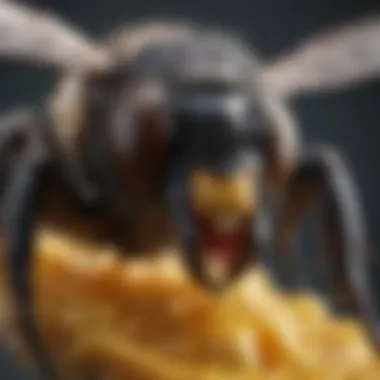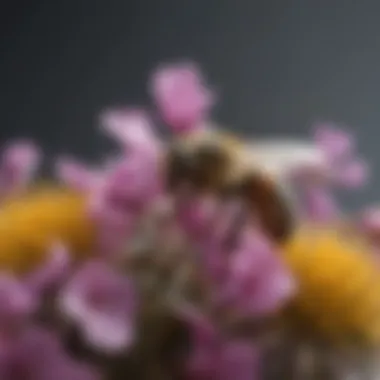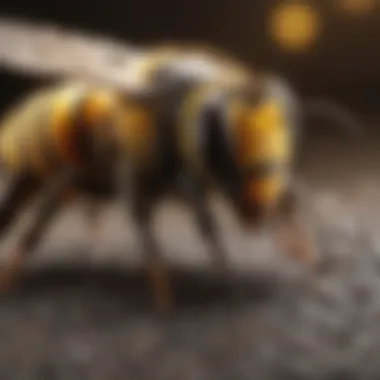Unraveling the Intricacies of the Bee Stinger's Anatomy and Functions


Animal Species Profile
Bees are fascinating creatures with a highly developed social structure and remarkable survival mechanisms. Their intricate anatomy and behavior have long been a subject of intrigue for scientists and nature enthusiasts alike. At the center of this complex world of bees lies the enigmatic bee stinger, a marvel of engineering and defense mechanism.
Physical Characteristics and Appearance
The bee stinger is a slender, barbed structure located at the posterior end of the bee's abdomen. It is primarily composed of chitin, a tough and rigid material that provides structural support and protection. The stinger is equipped with microscopic serrations and a venom sac, which work in unison to deliver venom effectively into the target.
Natural Habitat and Distribution
Bees can be found in various habitats worldwide, ranging from forests and meadows to urban gardens. They play a crucial role in pollination and ecosystem balance. Different species of bees have adapted to diverse environments, showcasing their versatility and resilience in the face of environmental changes.
Behavior and Social Interactions
Bees exhibit highly organized social behavior within their colonies, with designated roles for each member. The intricate dance of communication, resource-sharing, and hive maintenance reflects the collective intelligence of these tiny yet industrious insects. The bee stinger, as a tool of defense, underscores the importance of unity and cooperation among colony members for survival.
Unique Facts & Trivia
- Did you know that a honeybee's stinger is barbed, causing it to remain in the target after an attack, leading to the bee's death?
- Bees are capable of sensing pheromones released by their colony members, enabling them to communicate vital information such as food source locations and potential threats.
- Queen bees have the remarkable ability to control the fertility of the colony by selectively laying fertilized or unfertilized eggs, shaping the future workforce of the hive.
- Honeybees perform a fascinating 'waggle dance' to convey precise information about rich nectar sources, a sophisticated form of communication that aids in efficient foraging.
Conservation & Wildlife Efforts
Bees face numerous threats in the modern world, including habitat loss, pesticide exposure, and climate change. Conservation efforts have been instrumental in safeguarding bee populations and promoting biodiversity. Organizations around the globe work tirelessly to protect these vital pollinators and raise awareness about their declining numbers.
Overview of Conservation Status
The conservation status of bees varies depending on the species and region. Some rare bee species are at risk of extinction due to habitat destruction and intensive agriculture practices. It is crucial to monitor and regulate the factors contributing to bee population decline to ensure their long-term survival.
Threats to the Species
Pesticide use, pollution, disease, and habitat fragmentation pose significant threats to bee populations. The widespread decline of bees can have far-reaching consequences on ecosystem health and food security, making conservation efforts all the more urgent.
Conservation Initiatives and Organizations
Numerous conservation initiatives and organizations have been established to protect bees and their habitats. From establishing pollinator-friendly gardens to advocating for sustainable farming practices, these efforts aim to create a safer environment for bees to thrive.
Success Stories and Impact


Despite the challenges facing bee populations, there have been notable success stories in bee conservation. Through public awareness campaigns, pollinator protection laws, and habitat restoration projects, some bee species have experienced recovery and population growth. These initiatives highlight the importance of collective action in preserving biodiversity.
Pet Care & Tips
While bees may not be conventional pets, they play a crucial role in our ecosystem and require attention and protection. As responsible stewards of the environment, individuals can contribute to bee conservation efforts by creating pollinator-friendly spaces, avoiding pesticide use, and supporting local beekeeping practices.
Choosing the Right Pet for Your Lifestyle
For those interested in beekeeping, thorough research and training are essential to ensure the well-being of bee colonies. Understanding the commitments and challenges of bee care is vital for novice beekeepers to embark on this rewarding journey.
Basic Care Requirements and Habitat Setup
Bee colonies require a suitable habitat with access to nectar-rich flowers, clean water sources, and shelter from extreme weather conditions. Proper hive management and regular inspection are crucial for monitoring bee health and productivity.
Health and Wellness Tips for Pet Longevity
Maintaining bee health involves disease management, pest control, and nutrition optimization. Regular hive assessments and timely interventions are key to preventing and addressing potential threats to bee well-being.
Training Techniques and Behavioral Enrichment Ideas
While bees do not require traditional training like other pets, beekeepers can enhance bee behavior by providing diverse foraging opportunities, ensuring hive ventilation, and implementing swarm prevention strategies. Promoting natural behaviors and hive sustainability is essential for long-term bee colony success.
Introduction
The realm of a bee stinger offers a captivating journey into the intricate world of these remarkable insects. Understanding the significance of bees in ecosystems unveils a profound connection to the delicate balance of nature. Bees, with their remarkable role in pollination, serve as crucial intermediaries that facilitate the reproduction of various plants, including many of the crops essential for human consumption. On a broader scale, the impact of bees on food production underscores their irreplaceable contribution to sustaining biodiversity and food security worldwide.
The Significance of Bees in Ecosystems
The role of bees in pollination
The role of bees in pollination stands as a testament to their unparalleled importance in ecosystem dynamics. Bees, with their unique ability to transfer pollen from one flower to another, play a fundamental role in plant reproduction. This process not only ensures the survival of numerous plant species but also fosters genetic diversity within natural habitats. The specialized relationship between bees and flowering plants has evolved over millions of years, resulting in a finely tuned system that benefits both parties. However, the modern challenges faced by bee populations, such as habitat loss and pesticide exposure, threaten this intricate partnership, demanding urgent conservation efforts to safeguard biodiversity.
Impact of bees on food production
The impact of bees on food production extends far beyond their immediate role as pollinators. Nearly one-third of the world's food supply depends on pollination by bees, highlighting the indispensable nature of their services in agriculture. Without bees, many fruit and vegetable crops would struggle to set fruit and produce viable seeds, leading to significant disruptions in global food production. Consequently, the decline in bee populations poses a severe risk to food security and agricultural sustainability, prompting the need for holistic approaches that prioritize pollinator health alongside crop yields.
Overview of Bee Anatomy


Distinctive features of bees
The anatomy of bees showcases a myriad of distinctive features that reflect their specialized adaptations for various ecological roles. From their iconic striped appearance to the intricate structures of their mouthparts and antennae, bees exhibit a remarkable blend of form and function. One notable characteristic of bees is their specialized hairs, which help in the collection of pollen for feeding their larvae. Additionally, the complex compound eyes of bees provide them with exceptional visual acuity, crucial for navigation and locating floral resources across diverse landscapes. Understanding these distinctive features not only enhances our appreciation for bees' remarkable biology but also sheds light on the intricate mechanisms that govern their behaviors and ecological interactions.
Purpose of a Bee Stinger
Defensive mechanism against threats
The bee stinger serves as a critical defensive mechanism against threats, enabling bees to protect themselves and their colonies from potential dangers. Equipped with a barbed design, the stinger can effectively penetrate threats, delivering a potent venom that deters predators and intruders. This remarkable adaptation illustrates the evolutionary arms race between bees and their antagonists, shaping the dynamics of competition and survival in the natural world. However, the stinger's deployment comes at a cost, as it results in the bee's mortal injury and subsequent death, underscoring the sacrifices made in defense of the collective hive.
Tool for survival
Beyond its defensive function, the bee stinger serves as a multifaceted tool for survival, embodying the resilience and adaptability of these intricate insects. In addition to deterring predators, the stinger aids bees in foraging for resources, manipulating nesting materials, and communicating with fellow colony members through pheromone releases. This versatile instrument underscores the intricate interplay between morphology and behavior in shaping the evolutionary success of bees within diverse environmental contexts. By unraveling the complexities of the bee stinger's purpose, we gain a deeper appreciation for the sophisticated strategies that underpin bees' survival and resilience in the face of environmental challenges.
Structural Composition of a Bee Stinger
When delving into the enchanting complexities of a bee stinger, understanding its structural composition is paramount. The bee stinger is not just a simple tool; it is a meticulously crafted mechanism designed for multiple functions. By exploring the intricate details of its physical makeup, we gain profound insights into the evolutionary adaptations that have equipped bees with such a potent defense mechanism. The structural composition of a bee stinger encompasses various elements that work in harmony to serve the bee in its survival and defense strategies.
Physical Characteristics
Barbed design for penetration
The barbed design of a bee stinger is a marvel of nature's engineering. Unlike smooth stingers found in some other insects, the barbs on a bee's stinger serve a vital purpose. These tiny hooks on the stinger aid in anchoring the stinger into the target, ensuring that the bee can deliver its venom effectively. This unique feature of barbed design not only facilitates penetration but also maximizes the impact of the venom injection. While the barbed design poses challenges during stinger removal, it plays a crucial role in enhancing the defensive capabilities of bees.
Microscopic structure
Taking a closer look at the microscopic structure of a bee stinger reveals a world of intricacy. The stinger is composed of specialized cells and structures that work in unison to deliver venom with precision. The microscopic details of the stinger provide clues to its efficiency in releasing venom and inflicting harm on potential threats. Understanding the microscopic structure sheds light on how bees have evolved to fine-tune their defensive mechanisms, showcasing the remarkable adaptations that have enabled these creatures to thrive in diverse environments.
Venom Injection System
Delivery of venom into the target
The venom injection system of a bee stinger is a sophisticated apparatus designed for swift and precise delivery. When a bee deploys its stinger, the venom is swiftly propelled through the hollow shaft into the target. This efficient delivery mechanism ensures that the venom reaches the intended recipient swiftly, enhancing the bee's defensive capabilities. The delivery system of the venom sets bees apart in the insect world, showcasing the refined nature of their defensive strategies.
Comparative Analysis with Other Insects
Differences in stinger structure


A comparative analysis of bee stingers with those of other insects highlights the unique aspects of bee stingers. One significant difference lies in the presence of barbs on bee stingers, which distinguishes them from the smooth stingers of many other insects. This structural variance impacts the effectiveness of stinger deployment and underscores the evolutionary advantages that bees have gained through their specialized defensive mechanisms. Studying these differences provides valuable insights into the diverse adaptations that have arisen across insect species, showcasing the remarkable diversity in nature's design.
Functionality of a Bee Stinger
The Functionality of a Bee Stinger serves a vital role in the survival and defense mechanisms of bees. This section delves deep into how bees utilize their stingers as a defensive mechanism against threats and as a tool for survival. It highlights the intricate design of the stinger and explores its impact on the intricate relationship between bees and their environment. By understanding the functionality of the bee stinger, we can gain valuable insights into the complex world of these fascinating insects.
Protection Against Predators
Defense of the hive
The Defense of the hive is a crucial aspect of bee behavior that plays a significant role in protecting the colony from potential threats. Bees exhibit remarkable collective defense strategies to safeguard their hive from predators. The key characteristic of Defense of the hive lies in the coordinated efforts of worker bees to defend their home against intruders. This defensive behavior is a popular choice for this article due to its fundamental importance in bee survival. The unique feature of Defense of the hive is the use of pheromones to communicate danger among colony members, enhancing their ability to respond effectively to threats. Understanding the Defense of the hive provides valuable insights into the sophisticated defense mechanisms employed by bees.
Stinger Removal Process
Implications of stinger detachment
The Stinger Removal Process involves the detachment of the bee stinger after it has been used in defense. This process plays a crucial role in bee biology and behavior. The key characteristic of stinger detachment is its impact on the bee's well-being post-defense. It is a beneficial choice for this article as it sheds light on the sacrifices bees make to protect their colony. The unique feature of stinger detachment is that it results in the bee's death, as the stinger is ripped from its body along with the venom sac. This mechanism underscores the seriousness of bee stings and the ultimate price paid by the bees in their defensive efforts.
Repercussions of Bee Stings on Humans
Allergic reactions
The Repercussions of Bee Stings on Humans can range from mild irritation to severe allergic reactions. This section explores the intricacies of allergic responses to bee venom. The key characteristic of allergic reactions is the body's immune system overreacting to bee venom, leading to varying degrees of allergic responses. It is a significant choice for this article as it emphasizes the importance of bee sting awareness for human safety. The unique feature of allergic reactions is the potential life-threatening severity in some individuals, warranting immediate medical attention. Understanding the complexities of allergic reactions to bee stings is crucial for better preparedness and prevention strategies.
Treatment methods
The Treatment methods for bee stings play a crucial role in providing relief and managing allergic reactions. This section delves into the various treatment approaches for bee stings. The key characteristic of treatment methods is the importance of prompt action to alleviate symptoms and prevent complications. It is a popular choice for this article as it emphasizes the need for appropriate first aid measures in case of bee stings. The unique feature of treatment methods lies in the different options available, ranging from over-the-counter medications to emergency interventions for severe cases. By understanding the diverse treatment methods for bee stings, individuals can better prepare and respond effectively to bee sting incidents.
Conclusion
In unraveling the extensive intricacies of the bee stinger within this elucidative discourse, the importance of comprehending this minute yet potent appendage cannot be overstated. The bee stinger, beyond its physical structure and venomous capabilities, encapsulates a microcosm of evolutionary marvel and ecological significance. This exploration not only unveils the defensive and survival mechanisms governing bee behavior but also underscores the compelling interplay between stinger functionality and the broader ecosystem dynamics. By dissecting the nuanced roles that the bee stinger fulfills, we gain profound insights into the delicate balance that exists between bees and their habitat, fostering a deeper appreciation for the astounding complexity of nature's design.
Insights into Bee Stinger Functionality
Interconnectedness of bee biology and behavior
Delving into the intricacies of bee stinger functionality unfurls a tapestry of interconnectedness where bee biology and behavior converge in a symphony of adaptability and resilience. The symbiotic relationship between these elements transcends mere survival instincts, offering a glimpse into the intricate dance of evolution and adaptation. The pivotal role of interconnectedness lies in its ability to fine-tune bee behaviors to align with environmental cues, ensuring the perpetuation of bee colonies amidst ever-changing landscapes. This symbiosis underscores the bees' remarkable ability to coexist harmoniously with their surroundings, accentuating the unified front nature presents in the face of challenges.
Appreciation for Bee Adaptations
Impact of stingers on bee survival
An exploration of the bee stinger extends beyond its physical manifestation, delving into the profound impact it wields on bee survival. The stinger, acting as a dual-edged sword of defense and peril, stands as a poignant symbol of adaptation in the natural world. Its unique design, coupled with the venomous payload it delivers, underscores the stark reality of life and death woven into the fabric of bee existence. The strategic deployment of stingers not only safeguards hives against threats but also exemplifies the intricate strategies bees employ to ensure survival in demanding ecosystems. This homage to bee adaptations illuminates the awe-inspiring resilience intrinsic to these tiny yet resilient creatures, beckoning admiration for their unwavering perseverance in the face of adversities.







